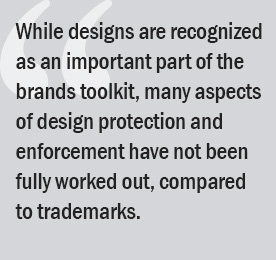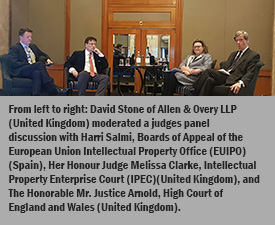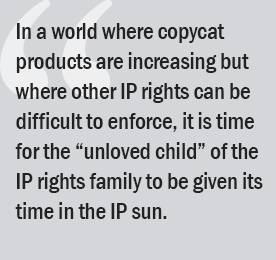Karin Hermansson, Patrix IP Helpware: Why We Exhibit at the INTA Annual Meeting
Published: March 15, 2018
 INTA’s “2018 Designs Conference: The Power of Design” was held in London from February 26‒27, 2018, and provided registrants with strategies and insight for protecting designs in a world in which designs have often been an “unloved child” of the IP world.
INTA’s “2018 Designs Conference: The Power of Design” was held in London from February 26‒27, 2018, and provided registrants with strategies and insight for protecting designs in a world in which designs have often been an “unloved child” of the IP world.
It’s Designs’ Time
Many of the speakers used their presentations as an opportunity to emphasize that it is time that designs were no longer perceived as an “afterthought” to trademark protection or, in the words of event Co-Chair Sheila Henderson (Richemont International Limited, UK), as “unloved children.” Indeed, Ms. Henderson helped attendees understand that designs are “hidden gems,” and INTA CEO Etienne Sanz de Acedo stressed in his opening address that it “makes total sense” for INTA to discuss the power of design, considering its value as an effective enforcement tool, but also as a cultural vehicle, with a significant role to play in corporate social responsibility (as recently highlighted at the Berlin Conference on Brand Authenticity).
While designs are recognized as an important part of the brands toolkit, many aspects of design protection and enforcement have not been fully worked out, compared to trademarks. This will undoubtedly change over time as case law develops. Co-Chairs Susie Arnesen (Loje Arnesen & Meedom, Denmark) and Ms. Henderson and their conference project team, put together an extremely impressive program covering the life of a design: from working with designers, to design clearance, registration, and enforcement. Panels comprised practitioners from a wide range of jurisdictions, including representatives of major national IP offices and WIPO, and in-house counsel from design-led companies, as well as those that have traditionally been more brand focused.
 Avoid the Traps
Avoid the Traps
Registrants were given best practice tips on how to work with in-house design teams (and other related departments, such as marketing) to ensure that robust and effective design protection is put in place before going to the market. While it may not always be easy to predict which design will be successful, and in which markets, there are certain key locations where protection should always be sought. For example, Daniel Plane (SIPS, Hong Kong) reminded the audience that, if you fail to register your designs in China, pirates may do so. There are also myriad traps to avoid when navigating the global design maze, including issues such as unity of invention, depiction techniques, multiple designs, priority, and grace periods. Alongside this are the challenges inherent in design clearance, with Ivan Sempere (PADIMA, Spain) expressing the hope that technology will develop to improve this process in the near future.
In addition to risk management, there are options to consider such as Hague Agreement filings, with Grégoire Bisson of the World Intellectual Property Organization reporting that the Russian Federation joined the Hague Union and will become a Hague System user as of February 28. Canada, Israel, and Mexico are expected to ratify by the end of 2018, and on March 13, 2018, the UK deposited the instrument of ratification needed to join the Hague System.
Judicial Insight and Brexit
The first day ended with a fascinating judges’ keynote panel chaired by David Stone (Allen & Overy, UK), with The Honorable Mr. Justice Arnold of the High Court of England and Wales, Her Honour Judge Clarke of the Intellectual Property Enterprise Court (IPEC), and Harri Salmi of the EUIPO Boards of Appeal. The judges provided insight into how they approach and decide design cases, including their preferences in how cases are presented; for example, in relation to the design corpus (prior art).
As for Brexit, while the UKIPO has not yet held Brexit discussions with the EUIPO, Stephen Rowan (Director of Trade Marks and Designs Directorate, UKIPO) reiterated that cooperation and information sharing between offices was ongoing. This was amply demonstrated in a session on the EUIPO/National IP Offices’ design convergence projects, which have led to significant time and cost savings for users, as well as for the Offices.
 Getting it Right
Getting it Right
By day two of the conference, two main themes had emerged: (1) the difficulty of clearance searches for designs, though it remains important to do the best possible job with the tools available, given the damage a product recall can cause; and (2) the overwhelming importance of getting your filing strategy right in a world where design laws are uneven, and where the time available to obtain valid registered protection is limited by the universal requirement that a design must be novel (or original) at the time it is applied for, subject to any applicable grace period.
The importance of getting one’s filing strategy right was highlighted in a well-received industry panel, where Laura Bonnes (Philips IP Standards, the Netherlands) described it as “a puzzle” and Natasha Hinds-Payne (Cath Kidston Ltd, UK) as “her biggest challenge.” First, one must try to identify what products are likely to be successful and have some longevity (referred to as “hero products” by James Sweeting, Superdry Plc, UK), and which will benefit from the longer period of protection provided by registration (as opposed to the shorter unregistered protection available in the EU). Second, one must identify what products are most likely to be copied. It is then important to identify in which countries it is crucial to file for protection, and to include not just major markets and one’s own sourcing countries, but also those jurisdictions from where copies are most likely to come. Once the “where” is determined, one must decide when to file, since grace periods for one’s own disclosure are not the same, and do not even exist in some countries. Finally, one must consider which designs to protect for any particular product, since this can be critical to establish design infringement. Ms. Bonnes advised to file for (1) the whole of the design; (2) the bare shape; and (3) those parts of the design which include key features.
Ms. Bonnes’ advice echoed a preceding talk on multi-national design enforcement, with Christopher Carani (McAndrews, Held & Malloy, USA) emphasising the need to layer protection by filing for multiple designs, including for the whole product, key features of the product, and parts of the product. Getting this right can be particularly important in the United States, where it is possible to recover the total (pre-tax) profit made by an infringing product in a successful claim.  In the same session, Sara Ashby (Wiggin LLP, UK) set out the complex jurisdictional rules if suing on the basis of an EU-registered (or unregistered) Community design right, and highlighted the importance of choosing the correct forum in which to bring a claim so as to provide the best chance of achieving pan-EU relief. Paolo Beconcini (Squire Patent Boggs, Hong Kong SAR, China) then added the perspective from China.
In the same session, Sara Ashby (Wiggin LLP, UK) set out the complex jurisdictional rules if suing on the basis of an EU-registered (or unregistered) Community design right, and highlighted the importance of choosing the correct forum in which to bring a claim so as to provide the best chance of achieving pan-EU relief. Paolo Beconcini (Squire Patent Boggs, Hong Kong SAR, China) then added the perspective from China.
A Sunny Future for Designs
The final afternoon included interesting talks on 3D printing and the importance of using the customs authorities, particularly in the EU, as part of an overall enforcement strategy. The talk emphasized the need, applicable to designs more than trademarks, to educate customs officers on what the design is, and what to look for in the appearance of other products to determine if they infringe. Again, this echoed the comments of the judges at the end of day one, who had stressed the importance of providing a clear schedule of the rights relied upon, including labeling the significant features of the design. The event Co-Chairs, Ms. Arnesen and Ms. Henderson, then summed up the conference with the message that, in a world where copycat products are increasing but where other IP rights can be difficult to enforce (e.g., nontraditional trademarks in Europe), it is time for the “unloved child” of the IP rights family to be given its time in the IP sun.
Although every effort has been made to verify the accuracy of items in the INTA Bulletin, readers are urged to check independently on matters of specific concern or interest.
© 2018 International Trademark Association
This website uses cookies so that we can provide you with the best user experience possible. Cookie information is stored in your browser and performs functions such as recognising you when you return to our website and helping our team to understand which sections of the website you find most interesting and useful.
To find out more please see our Cookies Policy and Privacy Policy.
These cookies are used to identify a user’s browser as the visitor goes from page to page on the Site. These are session cookies, which means that the cookie is deleted when you leave the Site. It is an integral piece of the Site software and used to let the server know which users are on the Site at any given time and make certain parts of the Site easier to use.
|
|
If you disable this cookie, we will not be able to save your preferences. This means that every time you visit this website you will need to enable or disable cookies again.
These cookies are used to collect information about how visitors use our Site. The cookies collect information in anonymous form, including the numbers of visitors to the Site, where visitors have come to the Site from, the pages they visited and how they have interacted with tools on the Site like search and embedded media players. We use the information to compile statistical reports of our users’ browsing patterns so that we can improve the Site.
|
|
Please enable Functionality Cookies first so that we can save your preferences!
These cookies are used to deliver advertising relevant to the interests of visitors to our Site. They are persistent, which means they will remain on your device after you leave the Site.
- Facebook (Ad Pixel)
- Google (Ad Pixel)
- LinkedIn (Ad Pixel)
- Quattro Anonymous
Please enable Functionality Cookies first so that we can save your preferences!
